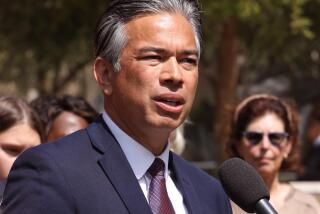Federal Feedback Positive on Otay Mesa Binational Airport Plan
- Share via
WASHINGTON — Federal officials are enthusiastic about the idea of building a binational airport at Otay Mesa, San Diego representatives said Friday after a whirlwind lobbying tour here.
Despite the novel immigration and customs problems posed by a binational airport, “no one said that it can’t be done,” said City Councilman Ron Roberts.
In a flurry of meetings with four federal agencies, the State Department, the Pentagon, Capitol Hill and the Mexican ambassador, San Diego city and county representatives spent two days promoting their proposal for an international airport to straddle the territories and jurisdictions of the United States and Mexico.
Roberts, who has been one of the strongest proponents of the idea, said the delegation wanted to find out from federal officials whether the idea was viable from Washington’s point of view.
“The answer, clearly, was ‘yes,’ ” he said.
Roberts said government reaction ranged from “cautious optimism” at the Immigration and Naturalization Service and the U.S. Customs Service, to “genuine enthusiasm” at the Department of Transportation and the Federal Aviation Administration.
“They are really singing our song,” concurred Galen J. Reser, an assistant secretary at the Transportation department. “It is not every city or region in the country that is thinking about the explosion of air traffic that we are going to see in the future. They are forward-thinking. They want to be ready for it.”
Last summer, both the INS and Customs voiced initial opposition to the idea. A binational airport “would severely impact upon Border Patrol operations,” the INS said in a letter to Rep. Duncan Hunter (R-Coronado), and the Customs Service complained to him that “such an airport would be a high-risk facility for the smuggling of aliens and drugs.”
But, in meetings Thursday and Friday, these agencies muted their opposition.
“Certainly we would have concerns about security, illegal migration of aliens and drug flow,” said Gene McNary, commissioner of the INS, “but we are always open to new ideas.”
“We have concerns but they are not negative concerns,” said Robert Bartol, director of the Customs Service office of passenger enforcement and facilitation. “We look at the issues as things to be resolved.”
Bartol said the Customs Service is still worried about increased opportunities for smuggling and the general difficulty of collecting tariffs and conducting border operations in a “binational enclave.” He said they could also face problems from “tangential activities” like hotels and car rental agencies that grow up around airports and crowd out land for government facilities.
The delegation traveled to Washington under the auspices of the regional planning commission, or Sandag (San Diego Assn. of Governments).
Roberts made the trip on behalf of Mayor Maureen O’Connor, who had planned to make the trip but stayed in California to be with her husband, who is ill. Other delegation members included Leon Williams, chairman of the San Diego County Board of Supervisors, Port Commission Chairman Milford Portwood and Lois Ewen, a Coronado councilwoman.
On Thursday evening, the group had a private meeting with the Mexican ambassador, Gustavo Petricioli, who advised them on the protocol for pursuing the airport plan with the Mexican government.
San Diego’s representatives in Congress are deeply divided over the idea of a binational airport. Only two of them, Reps. Ron Packard (R--Oceanside) and Bill Lowery (R--San Diego)--both supporters--showed up for a Thursday afternoon session in Washington. Packard said the airport plan has “great possibilities.
“We are in a rush because we are rapidly losing airport sites to development,” he explained. “All available sites will be gone in a few years. My colleagues may soon find that (Otay Mesa) may be the only logical site.”
Division in congressional ranks “won’t make it any easier” to gain federal approval, said Lowery.
Rep. Jim Bates (D--San Diego), who opposes the airport idea, said he boycotted the meeting because the lobbying trip is a “charade.
“The proposal is not well-conceived, it is not well-studied, and they are proceeding in an inadequate manner,” he said.
Rep. Hunter also opposes the airport plan, citing the danger of building a “cocaine gateway.”
Bates contended that the delegation had not adequately considered the option of joint military-civilian use of the Miramar Naval Air Station.
But Roberts reported that, in a meeting with U.S. Navy officials Thursday, the “message was loud and clear” that the Pentagon would block any joint use of Miramar.
Roberts said the final two meetings on Friday, with the Transportation Department and the FAA, were the “capstone” of the trip.
“They were the most familiar with the options,” he said, “so they were a little less scared “ by the binational concept.
There is only one operational multinational airport in the world--the international airport in Geneva, which is operated jointly by the French and Swiss governments.
Sandag is planning a trip to Mexico in mid-September to discuss the binational proposal with Mexican officials. Roberts said the next step after that will be to draw up a memorandum of understanding for reaching a final plan.
Lowery expressed hope that the proposed airport will be discussed at a U.S.-Mexican summit meeting between President Bush and Mexican President Carlos Salinas de Gortari next December. Presidential attention could move the issue forward more quickly, Lowery said, and avoid getting the plan bogged down in the bureaucracy.
More to Read
Sign up for Essential California
The most important California stories and recommendations in your inbox every morning.
You may occasionally receive promotional content from the Los Angeles Times.













